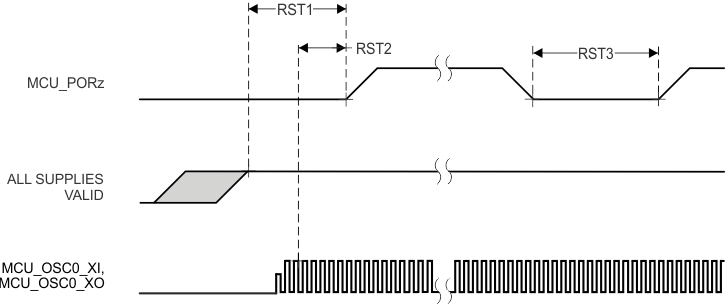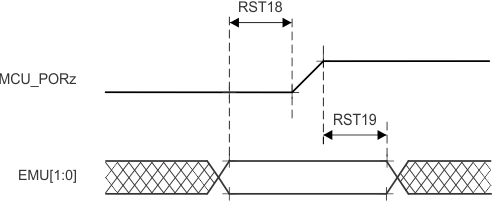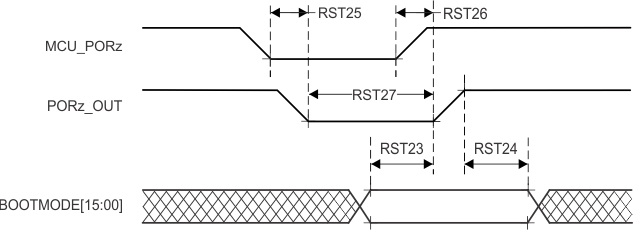ZHCSN84G January 2021 – April 2024 AM6411 , AM6412 , AM6421 , AM6422 , AM6441 , AM6442
PRODUCTION DATA
- 1
- 1 特性
- 2 应用
- 3 说明
- 4 器件比较
-
5 终端配置和功能
- 5.1 引脚图
- 5.2 引脚属性
- 5.3 信号说明
- 5.4 引脚连接要求
-
6 规格
- 6.1 绝对最大额定值
- 6.2 ESD 等级
- 6.3 上电小时数 (POH)
- 6.4 建议运行条件
- 6.5 运行性能点
- 6.6 功耗摘要
- 6.7 电气特性
- 6.8 一次性可编程 (OTP) 电子保险丝的 VPP 规格
- 6.9 热阻特性
- 6.10
时序和开关特性
- 6.10.1 时序参数和信息
- 6.10.2 电源要求
- 6.10.3 系统时序
- 6.10.4 时钟规格
- 6.10.5
外设
- 6.10.5.1 CPSW3G
- 6.10.5.2 DDRSS
- 6.10.5.3 ECAP
- 6.10.5.4 EPWM
- 6.10.5.5 EQEP
- 6.10.5.6 FSI
- 6.10.5.7 GPIO
- 6.10.5.8 GPMC
- 6.10.5.9 I2C
- 6.10.5.10 MCAN
- 6.10.5.11 MCSPI
- 6.10.5.12 MMCSD
- 6.10.5.13 CPTS
- 6.10.5.14 OSPI
- 6.10.5.15 PCIe
- 6.10.5.16 PRU_ICSSG
- 6.10.5.17 计时器
- 6.10.5.18 UART
- 6.10.5.19 USB
- 6.10.6 仿真和调试
-
7 详细说明
- 7.1 概述
- 7.2 处理器子系统
- 7.3 加速器和协处理器
- 7.4
其他子系统
- 7.4.1 PDMA 控制器
- 7.4.2
外设
- 7.4.2.1 ADC
- 7.4.2.2 DCC
- 7.4.2.3 双倍数据速率 (DDR) 外部存储器接口 (DDRSS)
- 7.4.2.4 ECAP
- 7.4.2.5 EPWM
- 7.4.2.6 ELM
- 7.4.2.7 ESM
- 7.4.2.8 GPIO
- 7.4.2.9 EQEP
- 7.4.2.10 通用存储器控制器 (GPMC)
- 7.4.2.11 I2C
- 7.4.2.12 MCAN
- 7.4.2.13 MCRC 控制器
- 7.4.2.14 MCSPI
- 7.4.2.15 MMCSD
- 7.4.2.16 OSPI
- 7.4.2.17 外设组件快速互连 (PCIe)
- 7.4.2.18 串行器/解串器 (SerDes) PHY
- 7.4.2.19 实时中断 (RTI/WWDT)
- 7.4.2.20 双模计时器 (DMTIMER)
- 7.4.2.21 UART
- 7.4.2.22 通用串行总线子系统 (USBSS)
- 8 应用、实施和布局
- 9 器件和文档支持
- 10修订历史记录
- 11机械、封装和可订购信息
6.10.3.1 复位时序
本节中提供的表和图定义了复位相关信号的时序条件、时序要求和开关特性。
表 6-4 复位时序条件
| 参数 | 最小值 | 最大值 | 单位 | ||
|---|---|---|---|---|---|
| 输入条件 | |||||
| SRI | 输入压摆率 | VDD(1) = 1.8V | 0.0018 | V/ns | |
| VDD(1) = 3.3V | 0.0033 | V/ns | |||
| 输出条件 | |||||
| CL | 输出负载电容 | 30 | pF | ||
(1) VDD 表示相应的电源。有关电源名称和相应焊球的详细信息,请参阅引脚属性 表的“电源”列。
表 6-5 MCU_PORz 时序要求 请参阅图 6-7
| 编号 | 参数 | 最小值 | 最大值 | 单位 | |
|---|---|---|---|---|---|
| RST1 | th(SUPPLIES_VALID - MCU_PORz) | 保持时间,在电源有效之后 MCU_PORz 在上电时有效(低电平)(使用外部晶体电路) | 9500000 | ns | |
| RST2 | 保持时间,在电源有效且外部时钟稳定之后 MCU_PORz 在上电时有效(低电平)(使用外部 LVCMOS 时钟源) | 1200 | ns | ||
| RST3 | tw(MCU_PORzL) | 脉冲宽度,在上电之后 MCU_PORz 为低电平(不移除电源或系统基准时钟 MCU_OSC0_XI/XO) | 1200 | ns | |
 图 6-7 MCU_PORz 时序要求
图 6-7 MCU_PORz 时序要求表 6-6 MCU_RESETSTATz 和 RESETSTATz 开关特性 请参阅图 6-8
| 编号 | 参数 | 最小值 | 最大值 | 单位 | |
|---|---|---|---|---|---|
| RST4 | td(MCU_PORzL-MCU_RESETSTATzL) | 延迟时间,MCU_PORz 有效(低电平)到 MCU_RESETSTATz 有效(低电平) | 0 | ns | |
| RST5 | td(MCU_PORzH-MCU_RESETSTATzH) | 延迟时间,MCU_PORz 无效(高电平)到 MCU_RESETSTATz 无效(高电平) | 6120*S(1) | ns | |
| RST6 | td(MCU_PORzL-RESETSTATzL) | 延迟时间,MCU_PORz 有效(低电平)到 RESETSTATz 有效(低电平) | 0 | ns | |
| RST7 | td(MCU_PORzH-RESETSTATzH) | 延迟时间,MCU_PORz 无效(高电平)到 RESETSTATz 无效(高电平) | 9195*S(1) | ns | |
| RST8 | tw(MCU_RESETSTATzL) | 脉冲宽度,MCU_RESETSTATz 低电平 (SW_MCU_WARMRST) | 966*S(1) | ns | |
| RST9 | tw(RESETSTATzL) | 脉冲宽度,RESETSTATz 低电平(SW_MCU_WARMRST、SW_MAIN_PORz 或 SW_MAIN_WARMRST) | 4040*S | ns | |
(1) S = MCU_OSC0_XI/XO 时钟周期(以 ns 为单位)。
 图 6-8 MCU_RESETSTATz 和 RESETSTATz 开关特性
图 6-8 MCU_RESETSTATz 和 RESETSTATz 开关特性表 6-7 MCU_RESETz 时序要求 请参阅图 6-9
| 编号 | 参数 | 最小值 | 最大值 | 单位 | |
|---|---|---|---|---|---|
| RST10 | tw(MCU_RESETzL)(1) | 脉冲宽度,MCU_RESETz 有效(低电平) | 1200 | ns | |
(1) 仅当所有电源有效且 MCU_PORz 已在指定时间内置为有效后,该时序参数才有效。
表 6-8 MCU_RESETSTATz 和 RESETSTATz 开关特性 请参阅图 6-9
| 编号 | 参数 | 最小值 | 最大值 | 单位 | |
|---|---|---|---|---|---|
| RST11 | td(MCU_RESETzL-MCU_RESETSTATzL) | 延迟时间,MCU_RESETz 有效(低电平)到 MCU_RESETSTATz 有效(低电平) | 0 | ns | |
| RST12 | td(MCU_RESETzH-MCU_RESETSTATzH) | 延迟时间,MCU_RESETz 无效(高电平)到 MCU_RESETSTATz 无效(高电平) | 966*S(1) | ns | |
| RST13 | td(MCU_RESETzL-RESETSTATzL) | 延迟时间,MCU_RESETz 有效(低电平)到 RESETSTATz 有效(低电平) | 960 | ns | |
| RST14 | td(MCU_RESETzH-RESETSTATzH) | 延迟时间,MCU_RESETz 无效(高电平)到 RESETSTATz 无效(高电平) | 4040*S(1) | ns | |
(1) S = MCU_OSC0_XI/XO 时钟周期(以 ns 为单位)。
 图 6-9 MCU_RESETz、MCU_RESETSTATz 和 RESETSTATz 时序要求和开关特性
图 6-9 MCU_RESETz、MCU_RESETSTATz 和 RESETSTATz 时序要求和开关特性表 6-9 RESET_REQz 时序要求 请参阅图 6-10
| 编号 | 参数 | 最小值 | 最大值 | 单位 | |
|---|---|---|---|---|---|
| RST15 | tw(RESET_REQzL)(1) | 脉冲宽度,RESET_REQz 有效(低电平) | 1200 | ns | |
(1) 仅当所有电源有效且 MCU_PORz 已在指定时间内置为有效后,该时序参数才有效。
表 6-10 RESETSTATz 开关特性 请参阅图 6-10
| 编号 | 参数 | 最小值 | 最大值 | 单位 | |
|---|---|---|---|---|---|
| RST16 | td(RESET_REQzL-RESETSTATzL) | 延迟时间,RESET_REQz 有效(低电平)到 RESETSTATz 有效(低电平) | 900*T(1) | ns | |
| RST17 | td(RESET_REQzH-RESETSTATzH) | 延迟时间,RESET_REQz 无效(高电平)到 RESETSTATz 无效(高电平) | 4040*S(2) | ns | |
(1) T = 复位隔离时间(取决于软件)
(2) S = MCU_OSC0_XI/XO 时钟周期(以 ns 为单位)。
 图 6-10 RESET_REQz 和 RESETSTATz 时序要求和开关特性
图 6-10 RESET_REQz 和 RESETSTATz 时序要求和开关特性表 6-11 EMUx 时序要求 请参阅图 6-11
| 编号 | 参数 | 最小值 | 最大值 | 单位 | |
|---|---|---|---|---|---|
| RST18 | tsu(EMUx-MCU_PORz) | 建立时间,MCU_PORz 无效(高电平)之前的 EMU[1:0] | 3*S(1) | ns | |
| RST19 | th(MCU_PORz - EMUx) | 保持时间,MCU_PORz 无效(高电平)之后的 EMU[1:0] | 10 | ns | |
(1) S = MCU_OSC0_XI/XO 时钟周期(以 ns 为单位)。
 图 6-11 EMUx 时序要求
图 6-11 EMUx 时序要求表 6-12 BOOTMODE 时序要求 请参阅图 6-12
| 编号 | 参数 | 最小值 | 最大值 | 单位 | |
|---|---|---|---|---|---|
| RST23 | tsu(BOOTMODE-PORz_OUT) | 建立时间,PORz_OUT 高电平之前的 BOOTMODE[15:00](外部 MCU PORz 事件或软件 SW_MAIN_PORz) | 3*S(1) | ns | |
| RST24 | th(PORz_OUT - BOOTMODE) | 保持时间,PORz_OUT 高电平之后的 BOOTMODE[15:00](外部 MCU PORz 事件或软件 SW_MAIN_PORz) | 0 | ns | |
(1) S = MCU_OSC0_XI/XO 时钟周期(以 ns 为单位)。
表 6-13 PORz_OUT 开关特性 请参阅图 6-12
| 编号 | 参数 | 最小值 | 最大值 | 单位 | |
|---|---|---|---|---|---|
| RST25 | td(MCU_PORzL-PORz_OUT) | 延迟时间,MCU_PORz 有效(低电平)到 PORz_OUT 有效(低电平) | 0 | ns | |
| RST26 | td(MCU_PORzH-PORz_OUT) | 延迟时间,MCU_PORz 无效(高电平)到 PORz_OUT 无效(高电平) | 1840 | ns | |
| RST27 | tw(PORz_OUTL) | 脉冲宽度,PORz_OUT 低电平(MCU_PORz 或 SW_MAIN_PORz) | 1200 | ns | |
 图 6-12 BOOTMODE 时序要求和 PORz_OUT 开关特性
图 6-12 BOOTMODE 时序要求和 PORz_OUT 开关特性